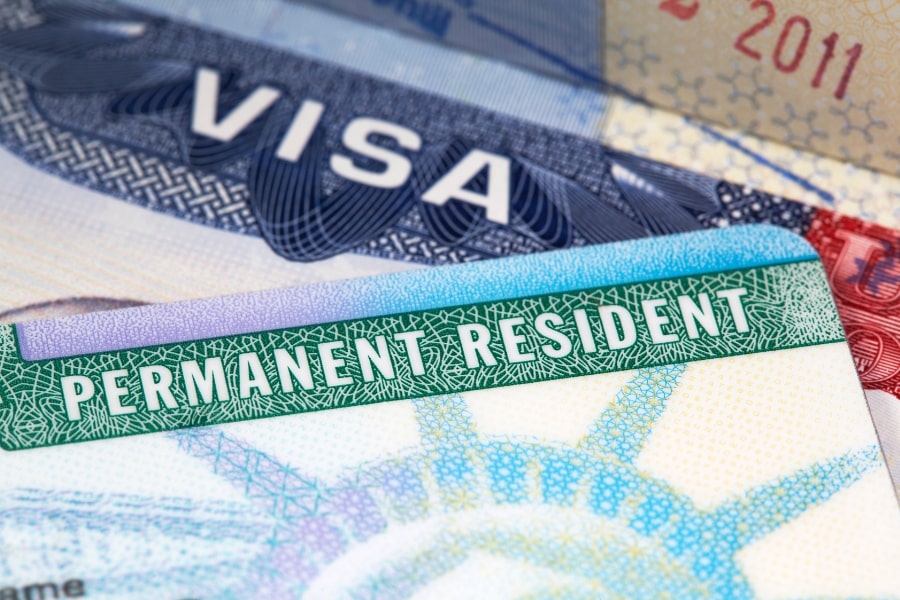This blog post was co-authored by Aaron Blumberg, Partner & Attorney at Fragomen.
Hiring an employee that needs sponsorship for a green card requires some extra paperwork but the benefits are plentiful. Offering sponsorship can help your business attract the best candidates from around the world. Additionally, green card sponsorship is needed if you want an employee to stay at the company longer than a temporary work visa would permit.
Types of Visas in the U.S.
There are two broad types of visas in the U.S. — temporary and permanent. Visas for permanent residence are referred to as green cards. Green Cards can generally be issued based on the following categories:
- Family-based
- Employment-based
- Diversity visa lottery
- Asylum and other humanitarian-based options
While it is possible to apply for more than one type of green card simultaneously, this guide will focus only on employment-based green cards. Spouses and unmarried children under 21 can be added to the employee’s green card petition.
Employment-Based Permanent Residence
As an employer, it’s important for you to have some understanding of the different types of employment-based green cards and the requirements for each.
EB-1: Priority Workers
The U.S. approves about 40,000 EB-1 visas per year. EB-1 has the highest standard and requirements for any green card application and is reserved for a select number of individuals. There is no degree needed for this visa, but there are stringent requirements that vary depending on the EB-1 category (there are 3 EB-1 sub-categories).
If the candidate is a person of extraordinary ability in science, arts, education, business, or athletics, they must meet three out of ten criteria to demonstrate their abilities. For professors and researchers, three years of teaching or research experience is required plus two out of six criteria to demonstrate their outstanding accomplishments in their field. Multinational executives and managers need one year of experience as a manager or executive in the past three years. The experience must be from outside of the U.S., with a company affiliated with the U.S. employer/sponsor.
EB-2: Advanced-Degree Professionals or Exceptional Ability
The EB-2 green card requires either an advanced degree, such as a master’s or Ph.D., or proven exceptional ability in science, art, or business.
EB-2 is a good option for professors seeking sponsorship for teaching positions because there is a particular green card process for teaching positions called EB-2 PERM Special Handling. Other occupations that require an advanced degree (lawyer, accountant, engineer, physician, etc.) could also qualify for EB-2.
The other unique option with EB-2 is the National Interest Waiver (NIW). EB-2 NIW is for those whose employment will benefit the U.S. in some significant way, such as scientists and entrepreneurs. There is no labor certification requirement for the NIW which means faster processing times.
EB-3: Professional, Skilled, and Unskilled Workers
EB-3 is the most commonly used employment-based (EB) green card category. EB-3 is the best option for many employees who do not have an advanced degree. It has three subcategories with different requirements:
- Professionals – bachelor’s degree required
- Skilled workers – 2 years of training and/or experience required
- Unskilled workers – limited to 10,000 visas per year
Permanent Residence Petition Process
There are generally three steps to sponsor an employee for permanent residency:
- PERM Labor Certification
- I-140 Petition for Alien Worker
- I-485 Adjustment of Status
For candidates applying for an EB-1 or EB-2 NIW green card, you can skip the PERM labor certification (Step 1).
PERM Labor Certification
PERM Labor Certification is a test that employers must complete through the Department of Labor (DOL) where they must prove that they are unable to find a minimally qualified US applicant for the sponsored position. There are generally some costs for completing Perm Labor Certification including job advertising and attorney fees. The employer is responsible for paying these. To help you understand the complicated labor certification process, we have broken it up into five stages.
Stage 1: Create a detailed job description for the position including the minimum education and experience required for the job. The job must be a full-time, permanent position. The job description should be generic, not geared towards the foreign national you want to sponsor.
Stage 2: The employee verifies that they meet the qualifications for the position based on the job description. They must also meet the general requirements for immigration to the U.S.
Stage 3: Submit a prevailing wage request. The DOL will provide a prevailing wage, which is the minimum wage that the employer must pay to sponsor a foreign national for this specific position. This is based on several factors such as the job responsibilities and location.
Stage 4: Post required recruitment materials. There are usually six different job advertisements that must be posted so that potential US applicants can apply. The advertisements can help prove that there are no qualified and available U.S. workers for the position.
Teaching positions are handled differently. The employer only needs to post one job ad, and there can be qualified and available U.S. applicants as long as the foreign national candidate is the most qualified for the position.
Stage 5: Submit Form ETA-9089 electronically to file your completed labor certification. Processing time for this form is currently about seven to eight months.
I-140 Petition for Alien Worker
The I-140 form is filed by the employer to USCIS and must include the labor certification described above if applicable to the candidate’s visa. The form must also show that the foreign national meets the requirements for the job and that the employer can pay the required salary for the position.
I-485 Adjustment of Status
Adjustment of status is filed by the foreign national by submitting the I-485 form. This step confirms the employee’s eligibility based on their immigration history, criminal history, medical exam and other pertinent personal information. The employee should check the U.S. Department of State’s employment-based visa bulletin to see when to file for adjustment of status. Candidates not currently in the U.S. will need to complete consular processing in their country of residence rather than adjustment of status.
Tips for Sponsoring Employees for Permanent Residence
One of the biggest concerns that employers have about sponsoring employees is how long it will take before they are approved. Generally, it takes two to three years to get an employer-sponsored green card after the petition is initially started; for people who qualify under EB-1, these processing times are generally cut in half. Keep in mind that green card processing times are based on the candidate’s country of birth not country of legal residence and backlogs currently exist for individual who were born in India and China.
Another common employer concern is whether or not the individual can work for the employer while the green card application is processing and whether they can travel internationally if needed. Having a temporary, dual intent visa (such as H or L visas) before they apply for a green card is strongly recommended as this allows the employee to work, live in the US and travel internationally throughout the green card process. There are two types of dual intent visas – H-1B and L-1.
Streamline the Process for Sponsoring Employees
Fragomen’s immigration experts make it easy to sponsor employees who are foreign nationals. As the largest and oldest immigration law firms, we know the ins and outs of the complex U.S. immigration system. We can help you and your employee determine which green card option is best for their specific circumstances and guide you throughout the permanent resident petition process.























